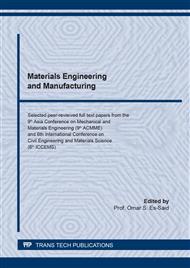[1]
Keserovic, A., & Bäßler, R. (2013, March). Material Evaluation for Application in Geothermal Systems In Indonesia. In CORROSION 2013. NACE International.
Google Scholar
[2]
Datuin, R., & Gazo, F. M. (1989). Material problems of geothermal power plants: a philippine experience. In Proc. 11th New Zealand Geothermal Workshop (pp.275-281).
Google Scholar
[3]
Kaya, T., & Hoshan, P. (2005, April). Corrosion and material selection for geothermal systems. In Proceedings World Geothermal Congress (pp.1-5).
Google Scholar
[4]
Schreiber, S., Lapanje, A., Ramsak, P., & Breembroek, G. (2016). Operational issues in geothermal energy in Europe: status and overview. Reykjavik (Iceland): Geothermal ERA NET.
Google Scholar
[5]
Harrar, J. E., Fischer, J. W., Beiriger, W. J., Steele, W. J., Digiallonardo, S. A., & McCoy, D. D. (1979). Incipient processes in the corrosion of mild steel in 90° C hypersaline geothermal brine. Corrosion Science, 19(11), 819-833.
DOI: 10.1016/s0010-938x(79)80107-9
Google Scholar
[6]
Mundhenk, N., Huttenloch, P., Sanjuan, B., Kohl, T., Steger, H., & Zorn, R. (2013). Corrosion and scaling as interrelated phenomena in an operating geothermal power plant. Corrosion Science, 70, 17-28.
DOI: 10.1016/j.corsci.2013.01.003
Google Scholar
[7]
Mundhenk, N., Huttenloch, P., Kohl, T., Steger, H., & Zorn, R. (2013). Metal corrosion in geothermal brine environments of the Upper Rhine graben–Laboratory and on-site studies. Geothermics, 46, 14-21.
DOI: 10.1016/j.geothermics.2012.10.006
Google Scholar
[8]
Landolt, D. (2007). Corrosion and surface chemistry of metals. CRC press.
Google Scholar
[9]
Goff SJ, Brophy P, Goff F. (2009). Environmental effects of geothermal power. Interactions Energy/Environment. Rybach L. Environmental aspects of geothermal.
Google Scholar
[10]
Perez, T. E. (2013). Corrosion in the oil and gas industry: an increasing challenge for materials. Jom, 65(8), 1033-1042.
DOI: 10.1007/s11837-013-0675-3
Google Scholar
[11]
Yu, S. Y., Choi, H. S., Lee, S. K., & Kim, D. K. (2014). Trend and review of corrosion resistant alloy (CRA) for offshore pipeline engineering. Journal of Ocean Engineering and Technology, 28(1), 85-92.
DOI: 10.5574/ksoe.2014.28.1.085
Google Scholar
[12]
Macrae, C. (2008). One pipe or two. Subtitle: Manufacturing Clad Pipe for Energy Applications. The Tube and Pipe Journal, [Online](Updated June 2008) Available at:< www. The fabricator. com/article/hydroforming/one-pipe-or-twor>[Accessed 28 Nov. 2013].
Google Scholar
[13]
Shannon, D. W. (1977). CORROSION OF IRON-BASE ALLOYS VERSUS ALTERNATE MATERIALS IN GEOTHERMAL BRINES (Interim Report-Period Ending October 1977) (No. PNL-2456). Pacific Northwest National Lab.(PNNL), Richland, WA (United States).
DOI: 10.2172/1107614
Google Scholar
[14]
Nogara, J., & Zarrouk, S. J. (2018). Corrosion in geothermal environment: Part 1: Fluids and their impact. Renewable and Sustainable Energy Reviews, 82, 1333-1346.
DOI: 10.1016/j.rser.2017.06.098
Google Scholar
[15]
Nogara, J., & Zarrouk, S. J. (2018). Corrosion in geothermal environment Part 2: Metals and alloys. Renewable and Sustainable Energy Reviews, 82, 1347-1363.
DOI: 10.1016/j.rser.2017.06.091
Google Scholar
[16]
F. X. McCawley, S. D. Cramer, W. D. Riley, J. P. Carter, and P. B. Needham, Jr. (1981). Corrosion of Materials and Scaling in Low-Salinity East Mesa Geothermal Brines. Report of Investigations 8504, United States Department of Interior Bureae of Mines, United States.
DOI: 10.2172/6883071
Google Scholar
[17]
American Petroleum Institute (API), 2009. API 5LD: Specification for CRA Clad or Lined Steel Pipe. American Petroleum Institute, USA.
Google Scholar
[18]
ASTM B443-19, Standard Specification for Nickel-Chromium-Molybdenum-Columbium Alloy and Nickel-Chromium-Molybdenum-Silicon Alloy Plate, Sheet, and Strip, ASTM International, West Conshohocken, PA, 2019, www.astm.org.
DOI: 10.1520/b0443-00e01
Google Scholar


